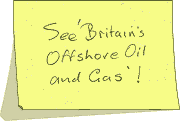
 |
 How are oil platforms constructed?
As many as 1000 workers may be needed to complete the construction and installation of an oil platform. These production platforms must be designed to withstand ferocious storm winds of up to 180 km/h, as well as the ever-present corrosive sea salt. Offshore operations
centre
Oil platforms have been described as 'industrial towns at sea'. Certainly the scale of their operations may make them seem so. In addition to drilling, the other main functions of an oil platform are as follows:
(An oil rig, not to be confused with a production platform, is a smaller, mobile structure used for drilling exploration wells.)
Physical labour is concentrated on the
drill floor where workers connect a series of 9-metre
lengths of drill pipe, which together are called a
drillstring. This drillstring is supported from above by
a towering structure called a derrick. A generator on the
platform powers a rotary table which spins. In the centre
of the rotary table is a square-sectioned pipe called a
kelly, which holds the drillstring (see diagram). Overcoming problems During drilling, specially prepared drilling mud is pumped down the hollow drillstring. This lubricates the drilling surface to prevent excessive friction and also prevents sudden pressure changes in the rocks, thus avoiding blowouts or gushers where oil might escape rapidly. The muddy fluid also removes ground-up rock from the drilling surface. (Among its ingredients are ground-up walnut shells which block up pores!) Completed sections of the well are lined with a casing of steel pipe and cemented into position. Each well can be closed off almost instantly in the event of a kick, a sudden backpressure as a result of oil, gas or water invading the well. This is done by a stack of powerful hydraulic jacks. Problems also arise if the drillstring becomes stuck (for example in heavy clay) or if pieces of equipment break. However, it is possible to jolt an embedded drillstring free, and fishing tools can retrieve damaged equipment. Pressure points The degree of success of oil and gas recovery depends fundamentally on the difference between the reservoir pressure and the well pressure, because in nature liquids and gases always flow from a higher to a lower pressure to create an equilibrium. If the natural pressure in the reservoir is high, then the oil and gas will be forced out like high-pressure air from a leaking tyre. However, if the natural pressure is insufficient, then water or gas must be injected into the reservoir to sweep its way through the rocks and force the fossil fuels out. This can improve recovery of oil by 15 to 50 per cent. If a well is not very productive, fluids can be pumped down under tremendous pressure to encourage the rocks to fracture, which would allow the oil and gas to flow. Acids are used to remove clogging mineral scale from the well which can gradually accumulate over years of production, in much the same way as vinegar is used to clear limescale from the clogged element of a kettle. Acids can also remove clogging minerals from the tiny pores in the reservoir rock, which improves the flow of oil. Piped ashore Most offshore oil and all offshore gas
is brought ashore by pipelines. Located under the sea,
they can operate in all weathers. Pipeline routes are
designed to be as short as possible but must avoid
unstable areas. The pipes are waterproofed with bitumen
and encased in steel-reinforced concrete to prevent them
rising when full of gas. They are welded together at sea
before being guided to the seabed. Where tankers
transport oil from small or isolated fields, the oil must
be pumped to a storage cell away from the main platform
for transfer to the tanker, as it would be dangerous to
try to manoeuvre a large vessel close to an oil platform.
Many regulations and guidelines exist for the safe
transportation of oil. However, such infamous names as
the Torrey Canyon (UK, 1967), Amoco Cadiz
(Brittany, 1978), Exxon Valdez (Alaska, 1989), Aegean
Sea (Spain, 1992) and Braer (Shetlands, 1993)
remind us that human error or exceptional circumstances
can cause environmental pollution on a vast and
disastrous scale. |
||||||||||||||